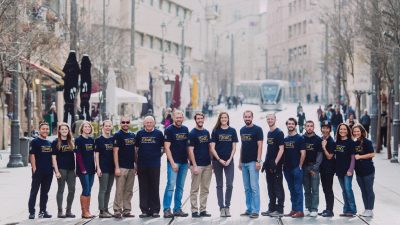×


We have detected your country as:
Please click here to go to the USA website or select another country from the dropdown list.
by: Abigail Gilbert, BFP Staff Writer

A team of Bridges for Peace volunteers enrolled in the 8th annual Jerusalem Winner Marathon this year to raise money for victims of terror.
On marathon day, everything in Jerusalem comes to a halt. Everything except 30,000 runners, that is.
Every spring, Jerusalem’s historic streets clear for thousands of runners from Israel and around the world to stream through the city during the Jerusalem Winner’s Marathon. The marathon started back in 2011 when Jerusalem Mayor Nir Barkat, an avid runner himself, decided he wanted a marathon that qualified with world standards right in his hometown. The event was an immediate hit, quickly gathering speed from 10,000 participants the first year to a registered 30,000 runners for this year’s March 9th event.
In his welcome letter to everyone running in the 8th annual Jerusalem marathon this year, Barkat wrote “participants run through the very streets where kings and prophets walked, against the backdrop of Jerusalem’s cultural and historical landscapes.”
The marathon route is characterized by steep climbs and deep valleys. In 2014, Runner’s World writer Rachel Toor called it the “most difficult urban marathon I’ve ever run.” Women’s Running ranked the Jerusalem hills up there with the Boston Marathon’s famous “Heartbreak Hill,” and the exhausting Pikes Peak Marathon.
Still, online runner forums and race reviews pretty much agree: while the hills are nothing to sniff at, the chance to “run where the prophets walked” is worth the burn. The route loops around Jerusalem’s famous cultural and heritage sights. It begins at the Knesset, going from there to the outdoor Machane Yehuda marketplace, where vendors still hawk their wares despite the onslaught of neon-clad runners. The route passes Mount Scopus, David’s Tower and the Haas Promenade overlooking the Old City—it even passes through the Old City itself, where runners often shorten their stride to manage the uneven stones between Jaffa Gate and Zion Gate.
The test of endurance is made somewhat easier by the distraction of 3,000 years of history passing beneath your feet, and the people who come from all over the city to cheer “Kol Ha’Kavod” (Well done! Good job!). Thousands line the streets with signs and shouts of encouragement, and many corners boast local bands, playing old favorites for the passing athletes.
Runners come from more than 60 different countries to participate, with over 6,000 running to support social causes and charities. Last year, Israeli judo gold medalist Ori Sasson ran with team Shalva to support children with disabilities. A team of Bridges for Peace runners is enrolled this year and will raise money for victims of terror.
The money will go to build bomb shelters in at-risk communities, aid burn victims, help the handicapped, and provide support to children and families who have been touched by terrorism, that they may say again: “You have turned for me my mourning into dancing; you have put off my sackcloth and clothed me with gladness” (Ps. 30:11).
This message is especially poignant at an event like the Jerusalem Marathon. Last year, after an ongoing terror threat led some news organizations to speculate on a smaller crowd of runners, Barkat said the following in an article to marathon attendees. “Through the greatest of trials, Jerusalem does not cancel events. It’s part of our message. We will carry on as usual.”
And that certainly held true. So many people signed up in 2016, both international runners and those from within Israel, that the race broke the 2015 record for participants. A few out-of-town runners reviewing the race online noted that they’d been warned about violence in the area before they arrived, and were pleasantly surprised to find the streets lined with cheering, supportive people instead of the crowds of unruly protestors.
The marathon is a snapshot of modern Jerusalem, where the everyday and the holy walk hand-in-hand. Jogging isn’t separated from the stones of the city where His name rests. Children play on the stone lions, and bluegrass fits into the historic neighborhoods. Out-of-town runners find themselves shoulder to shoulder with Israelis who point out sites and banter about the intensity of the hills and the man dressed up like Batman running up ahead. The 26.2-mile (42 km) tour of Jerusalem shows a beautiful, ancient city, at some points challenging and torn, but still whole. Still alive. Still a light.
Photo Credit: Michio Nagata/bridgesforpeace.com
All logos and trademarks in this site are property of their respective owner. All other materials are property of Bridges for Peace. Copyright © 2024.
Website Site Design by J-Town Internet Services Ltd. - Based in Jerusalem and Serving the World.